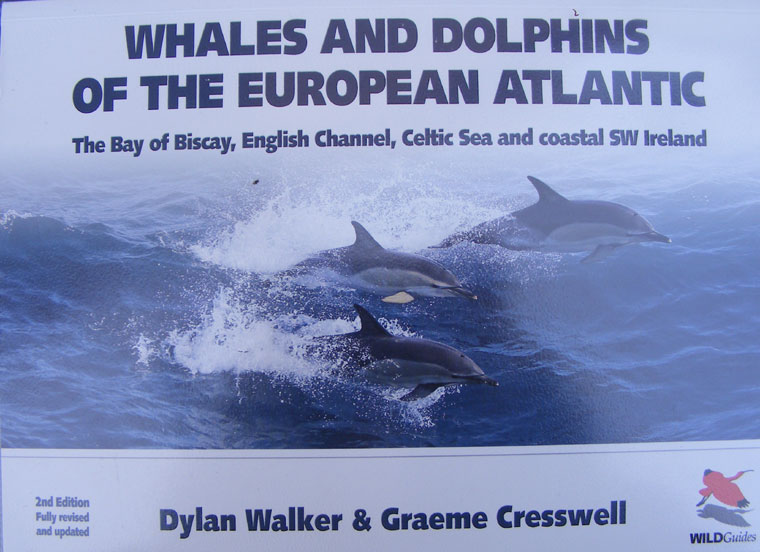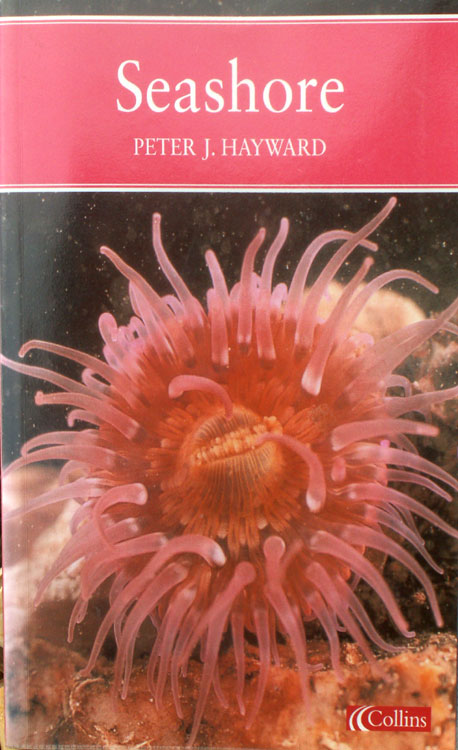|
PUBLICATIONS
&
WEB PAGES
BOOKS
PUBLICATIONS
NEW BOOK

A Field Guide to
Marine Fishes of Wales and Adjacent Waters
by
Paul Kay & Frances Dipper
£19.95
incl. p&p
Soft
cover
With
256 pages and numerous photographs supported by drawings, this book is
the most comprehensive photographic guide to marine fish currently available
in the UK. Published for the Marine
Conservation Society with support from the Countryside Council for
Wales.
Click
on the image to order this book through the Marine
Conservation Society
RECOMMENDED
PURCHASE *****
July
2010
SEASHORE
SAFARIS
Publisher:
Graffeg
Publisher's
Review (click on this text)
Review
by the City and County of Swansea
This
is the book I should have written (and I dare say a few others as well)
and is a much needed introduction to the world of the seashore and the
hobby of rockpooling. It is a photographic guide
to most of the common species encountered which is much appreciated as
newcomers and even experienced rockpoolers will try and match up what they
have seen to a visual image (and photographs work better than line drawings)
and this will usually get them the correct species, (unless there are two
very alike species and then you will need a specialist identification guide
like the Collins
Guide to the Seashore).
However,
the seashore is a rich and interesting habitat with a myriad of species
and 225 pages of this large pocket guide are comprehensively covered to
suit the enthusiast.
Extract
from the foreword by Keith Hiscock:
"Being
able to names to what you see and, better still, to use your observations
to add to our knowledge about the natural world is what this book is about."
But
the book for a popular audience is more than this. It starts from the assumption
that the parents and teachers and older children are unfamiliar with the
seashore environment, so the
1.
Getting started
explains
about the tides (very briefly: a detailed explanation can be in chapter
2) and the equipment you may need, where and how to look for the seashore
critters (my term).
2.
Living between the tides
explains
about the dynamic nature of the littoral environment and the variations
on different coasts. It also introduces the explorer to a few technical
terms which are further explored in
3.
Zonation
which
is a rather important explanation to on what part of the shore what animals
and seaweeds are to be discovered and why
4.
Habitats
Even
between the zones the geography of the seashore varies and this chapter
explains what habitats what type of creatures
5.
Beachcombing
This
is the scavenger's first introduction to the see what the sea has deposited
on the strandline complete with an excellent quick guide to the common
shells and other treasures
6.
Animal Life
The
large animal life section is structured roughly by phyla (major groups
of animals) ignoring for the most part the specialist microscopic studies.
Each animal group is given a brief description including behavioural characteristics.
Each animal is given a common name and the important scientific name (because
the common names can vary in different localities and in different books)
with a photograph, brief written description, habitat preferences and field
notes.
"Did
you know?
Male
crabs have a narrow 'v' shaped tail with 5 joints and in females the tail
is wider with 7 joints."
Fish
are the most interesting discoveries for many of the fledgling rockpoolers.
Most of the common species are included but a frequently encountered species
like the Rock Goby, Gobius paganellus,
has been omitted.
7.
Seaweeds
In
contrast to the fish the common macroalgae are well covered.
8.
Conservation
This
is a good section encouraging participants to take an active interest,
how the public can help and a comprehensive list of where to report their
findings.
9.
Further Information
With
a book list and a list of organisations and their web pages, a comprehensive
glossary and an index, this has the hook that could result in a lifetime
interest in the seashore.
Now
why would anybody want to go to Serengeti
when we have so much of interest nearer to home?
RECOMMENDED
PURCHASE *****
by
Andy
Horton (August 2010)
Oakley
Intertidal on Facebook
BMLSS
Guide Books
June
2009
The
Edible
Seashore (River Cottage Handbook No. 5)
by
John
Wright was published
Not
just a cookery book: you have to go down to the shore and catch or collect
the food yourself. The 240 page hardback book (with an index) is exceptionally
well produced in quality of the binding, paper as well as the quality of
writing, information and clear useful colour photographs. It is well organised
into nine chapters:
Starting
Out: Conservation and Equipment, including the first paper published
instructions on how to construct a shrimp
net (push-net).
Foraging:
Lots of useful and essential information about the tides, weather, safety
and what to wear.
Rule
Book: This is the bravest inclusion. John
Wright attempts (better than anyone so far)
to explain the rules, law and ethics of seashore collection, what you are
allowed and not allowed to do. It is worth buying the book for this chapter
alone.
The
Flowering Plants
The
Seaweeds
The
Molluscs
The
Crustaceans
All
the expected species and some unlikely edible candidates are included and
each is given two pages. Very informative and lots of information I did
not already know. John Wright
conducted his research first hand and we shrimped
together on Southwick Beach with Peter Talbot-Elsden
(as shown in my photograph, not in the book).
The
Recipes: Well I would omit the chilli in the Potted
Shrimp. After collecting the food, I am usually
a wee bit tired and this chapter should be for your partner. Let me know
how you get on?
The
home-made shrimp
net on page 17 is an identical design to mine, the one used by John
Wright before he made his own on our expeditions
at Southwick, and the one used by Charlie
Dimmick on River Walks filmed on nearby Lancing
beach.
Conclusion:
Highly
recommended, essential purchase ***** (highest five star rating).
BMLSS
Shrimping
-------------------------------------------------------------------------------------------------------------------
Kimmeridge
Tidings
Autumn 2009
http://www.dorsetwildlifetrust.org.uk/c2/uploads/tidingsautumn09web.pdf
Up
to date with all the latest happenings at our Purbeck
Marine Wildlife Reserve in Kimmeridge.
VIVARIUM
by
Peter Stiles
Publisher:
Museum
of Barnstaple and North Devon
Philip
Henry Gosse was a popular naturalist who moved to Victorian Ilfracombe
and wrote his natural science book ‘A
Naturalist’s Rambles on the Devonshire Coast’. He later designed the
first public aquarium, which opened in London. His activities also attracted
other naturalists, including Charles Darwin and novelist George Eliot.
This
book celebrates the link between Philip Henry Gosse and his rockpool
adventures in Devon and contains lots of information about the life of
this self-taught Victorian scientist and writer.
in
conjunction with an Exhibition
that finished on 25 April 2009.
Marine
Fisheries Science Yearbook 2008/2009
Publisher:
defra
href="http://archive.defra.gov.uk/search/results.htm?cx=014361324438485032053%3Aljunwq2pe_y&cof=FORID%3A11&ie=UTF-8&q=Marine+Fisheries+Science+">To
obtain a copy from the defra web site, click on this text
 |
Sharks
in British Seas
Richard
Peirce
138
pages, colour illustrations, line drawings, colour & b/w photos.
Lots
of newspaper reports.
Publisher:
Shark Cornwall
Softcover
| 2008 | £9.99
ISBN:
978-0-955869402
|

Whales
& Dolphins
of
the European Atlantic
The
Bay of Biscay, English Channel, Celtic Sea and coastal SW Ireland
by
Dylan Walker and Graeme Cresswell
with
the illustrations by Robert Still
WILDGuides
2008
£
12.00 (includes standard UK P&P)
ISBN:
978-1-903657-31-7
This
is the second fully revised and updated edition of this comprehensive guide
to the identification of whales, dolphins and porpoises (collectively known
as cetaceans) in the European Atlantic. Until very recently, most researchers
and whale-watchers were unaware of the great variety of cetaceans that
can be seen so close to the shores of western Europe. Indeed, it is only
during the last decade, when detailed cetacean surveys have been carried
out in earnest, that we have discovered how important this area is for
cetacean biodiversity.
This
field guide describes all of the 31 species of whale, dolphin and porpoise
that have occurred in the European Atlantic.
BMLSS
Cetacean Book Reviews
The
Gulf Stream
by
Bruno Voituriez
Publisher:
UNESCO
ISBN:
92-3-103995-4
222
pages, figures, glossary, bibliography
The
Gulf Stream
Amid
contemporary scenarios of potential climatic catastrophes and global warming
that might be imagined to bring a new ice age, the powerful image of the
Gulf Stream rising from the Florida Straits and flowing to the north Atlantic
inevitably provokes questions about its ecological significance and whether
it might ever stop.
Coastal
Plankton
Photo Guide for
European Seas
by
Otto Larink & Wilfried Westheide
reviewed
by Wim van Egmond
 |
Seashore
(Collins
New Naturalist) (Paperback)
by
Peter Hayward
Collins
2004
ISBN:
0-00-220031-7
Amazon
Web Site |
Paperback.
Pp 288. Colour & b/w photographs, illustrations, charts, maps and bibliography.
Fine copy. "New Naturalist" Seashore is a comprehensive, authoritative
account of the natural history of the seashore.
BMLSS
General Guides
BMLSS
Advanced Guides
.
JOURNALS:
SAVE
OUR SEABIRDS NETWORK
Working
to reduce Marine Pollution and to help the birds caught in it
Quarterly
Newsletter
Registered
Charity 803473
------------------------------------------------------------------------------------------------------------------
WEB
SITES
Decision-making
in Marine Mammal
Rescue
and Rehabilitation
Eastern
English Channel Habitat Atlas for Marine Resource Management
is
available for download from
http://charm.canterbury.ac.uk/atlas/pge.htm
Encyclopaedia
of Marine Life of Britain and Ireland
http://www.habitas.org.uk/marinelife/index.html?item=about
Marine
Fauna of Norway
http://www.seawater.no/fauna/e_index.htm

WET
THUMB (Marine Aquariology)
EFORUM
PAGE
BMLSS:
Marine Life Articles in Publications (Link)
|

